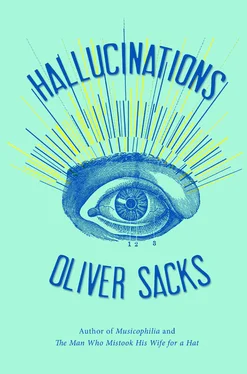Hallucinations often seem to have the creativity of imagination, dreams, or fantasy — or the vivid detail and externality of perception. But hallucination is none of these, though it may share some neurophysiological mechanisms with each. Hallucination is a unique and special category of consciousness and mental life.
The hallucinations often experienced by people with schizophrenia also demand a separate consideration, a book of their own, for they cannot be divorced from the often profoundly altered inner life and life circumstances of those with schizophrenia. So I will refer relatively little to schizophrenic hallucinations here, focusing instead on the hallucinations that can occur in “organic” psychoses — the transient psychoses sometimes associated with delirium, epilepsy, drug use, and certain medical conditions.
Many cultures regard hallucination, like dreams, as a special, privileged state of consciousness — one that is actively sought through spiritual practices, meditation, drugs, or solitude. But in modern Western culture, hallucinations are more often considered to portend madness or something dire happening to the brain — even though the vast majority of hallucinations have no such dark implications. There is great stigma here, and patients are often reluctant to admit to hallucinating, afraid that their friends and even their doctors will think they are losing their minds. I have been very fortunate that, in my own practice and in correspondence with readers (which I think of, in some ways, as an extension of my practice), I have encountered so many people willing to share their experiences. Many of them have expressed the hope that telling their stories will help defuse the often cruel misunderstandings which surround the whole subject.
I think of this book, then, as a sort of natural history or anthology of hallucinations, describing the experiences and impact of hallucinations on those who have them, for the power of hallucinations is only to be understood from firstperson accounts.
Some of the chapters that follow are organized by medical categories (blindness, sensory deprivation, narcolepsy, etc.), and others are organized by sensory modality (hearing things, smelling things, etc.). But there is a great deal of overlap and interconnection between these categories, and similar hallucinations may occur in a wide variety of conditions. Here, then, is a sampling which I hope will give a sense of the great range, the varieties, of hallucinatory experience, an essential part of the human condition.
1. Silent Multitudes: Charles Bonnet Syndrome
One day late in November 2006, I got an emergency phone call from a nursing home where I work. One of the residents, Rosalie, a lady in her nineties, had suddenly started seeing things, having odd hallucinations which seemed overwhelmingly real. The nurses had called the psychiatrist in to see her, but they also wondered whether the problem might be something neurological — Alzheimer’s, perhaps, or a stroke.
When I arrived and greeted her, I was surprised to realize that Rosalie was completely blind — the nurses had said nothing about this. Though she had not seen anything at all for several years, she was now “seeing” things, right in front of her.
“What sort of things?” I asked.
“People in Eastern dress!” she exclaimed. “In drapes, walking up and down stairs … a man who turns towards me and smiles, but he has huge teeth on one side of his mouth. Animals, too. I see this scene with a white building, and it is snowing — a soft snow, it is swirling. I see this horse (not a pretty horse, a drudgery horse) with a harness, dragging snow away … but it keeps switching.… I see a lot of children; they’re walking up and down stairs. They wear bright colors — rose, blue — like Eastern dress.” She had been seeing such scenes for several days.
I observed with Rosalie (as with many other patients) that while she was hallucinating, her eyes were open, and even though she could see nothing, her eyes moved here and there, as if looking at an actual scene. It was that which had first caught the nurses’ attention. Such looking or scanning does not occur with imagined scenes; most people, when visualizing or concentrating on their internal imagery, tend to close their eyes or else to have an abstracted gaze, looking at nothing in particular. As Colin McGinn brings out in his book Mindsight , one does not hope to discover anything surprising or novel in one’s own imagery, whereas hallucinations may be full of surprises. They are often much more detailed than imagery, and ask to be inspected and studied.
Her hallucinations, Rosalie said, were more “like a movie” than a dream; and like a movie, they sometimes fascinated her, sometimes bored her (“all that walking up and down, all that Eastern dress”). They came and went, and seemed to have nothing to do with her. The images were silent, and the people she saw seemed to take no notice of her. Apart from their uncanny silence, these figures seemed quite solid and real, though sometimes two-dimensional. But she had never before experienced anything like this, so she could not help wondering: was she losing her mind?
I questioned Rosalie carefully but found nothing suggestive of confusion or delusion. Looking into her eyes with an ophthalmoscope, I could see the devastation of her retinas but nothing else amiss. Neurologically, she was completely normal — a strong-minded old lady, very vigorous for her years. I reassured her about her brain and mind; she seemed, indeed, to be quite sane. I explained to her that hallucinations, strangely, are not uncommon in those with blindness or impaired sight, and that these visions are not “psychiatric” but a reaction of the brain to the loss of eyesight. She had a condition called Charles Bonnet syndrome.
Rosalie digested this and said she was puzzled as to why she had started having hallucinations now, after being blind for several years. But she was very pleased and reassured to be told that her hallucinations represented a recognized condition, one that even had a name. She drew herself up and said, “Tell the nurses — I have Charles Bonnet syndrome.” Then she asked, “Who was this Charles Bonnet?”
Charles Bonnet was an eighteenth-century Swiss naturalist whose investigations ranged broadly, from entomology to reproduction and regeneration in polyps and other animalcules. When an eye disease made his beloved microscopy impossible, he turned to botany — he did pioneer experiments on photosynthesis — then to psychology, and finally to philosophy. When he heard that his grandfather Charles Lullin had started to have “visions” as his eyesight failed, Bonnet asked him to dictate a full account.
John Locke, in his 1690 Essay Concerning Human Understanding , put forward the notion that the mind is a tabula rasa until it receives information from the senses. This “sensationalism,” as it was called, was very popular with the philosophes and rationalists of the eighteenth century, including Bonnet. Bonnet also conceived of the brain as “an organ of intricate composition, or rather an assemblage of different organs.” These different “organs” all had their own dedicated functions. (Such a modular view of the brain was radical at the time, for the brain was still widely regarded as undifferentiated, uniform in structure and function.) Thus Bonnet attributed his grandfather’s hallucinations to continuing activity in what he postulated were visual parts of the brain — an activity drawing on memory now that it could no longer draw on sensation.
Bonnet — who would later experience similar hallucinations when his own eyesight declined — published a brief account of Lullin’s experiences in his 1760 Essai analytique sur les facultés de l’âme , a book devoted to considering the physiological basis of various senses and mental states, but Lullin’s original account, which filled eighteen pages of a notebook, was subsequently lost for nearly 150 years, coming to light only at the beginning of the twentieth century. Douwe Draaisma has recently translated Lullin’s account, including it in a detailed history of Charles Bonnet syndrome in his book Disturbances of the Mind . 4 4 Draaisma’s book provides not only a vivid account of Bonnet’s life and work, but fascinating reconstructions of the lives of a dozen other major figures in neurology whose names are now remembered mostly for the syndromes named after them: Georges Gilles de la Tourette, James Parkinson, Alois Alzheimer, Joseph Capgras, and others.
Читать дальше












